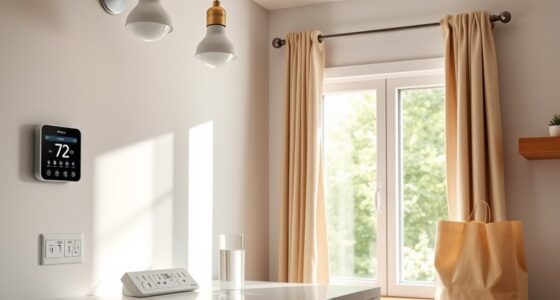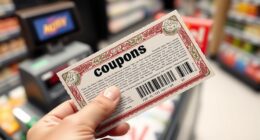To compare reusable and disposable items, start by calculating their initial costs, usage frequency, and lifespan. Reusables often have higher upfront expenses but lower costs per use over time, while disposables are cheaper initially but add up with frequent use. The break-even point is reached when the total cost of reusables, including maintenance, equals disposable expenses. Understanding these factors helps you decide when long-term savings and environmental benefits outweigh initial investments—stay tuned to explore the specifics involved.
Key Takeaways
- Calculate the initial cost divided by the number of uses to find the cost per use for both reusables and disposables.
- Determine the break-even point where total costs of reusables equal cumulative costs of disposables over time.
- Include maintenance, cleaning, and replacement costs for reusables in break-even calculations.
- Consider environmental benefits alongside financial costs to evaluate long-term sustainability and savings.
- Reusables often become more cost-effective than disposables after a certain number of uses, depending on initial and ongoing expenses.
Initial Investment and Purchase Costs

When comparing initial investment and purchase costs, reusable items typically require a higher upfront expense than disposable ones. You’ll pay more initially for durable products like washable containers or cloth bags because they’re made from sturdier materials designed to last. Disposable items, such as plastic utensils or single-use packaging, cost less per unit and are often cheaper to buy initially. However, while reusable options seem more expensive upfront, they can save you money over time. If you use them frequently, the initial investment gets spread out, making the cost per use lower. Additionally, considering the environmental benefits can influence your decision, as reusable items reduce waste and contribute to sustainability. The durability and long-term usability of reusable products also play a crucial role in their cost-effectiveness. On the other hand, if your usage is infrequent, the higher upfront cost might not be justified. So, your choice depends on how often and how long you plan to use each item. Additionally, appliance maintenance plans can help reduce long-term costs by preventing unexpected repairs, similar to how choosing durable reusable items can save money over time. Incorporating cost-effective strategies can further optimize your spending and enhance the value you get from your investments.
Usage Frequency and Durability
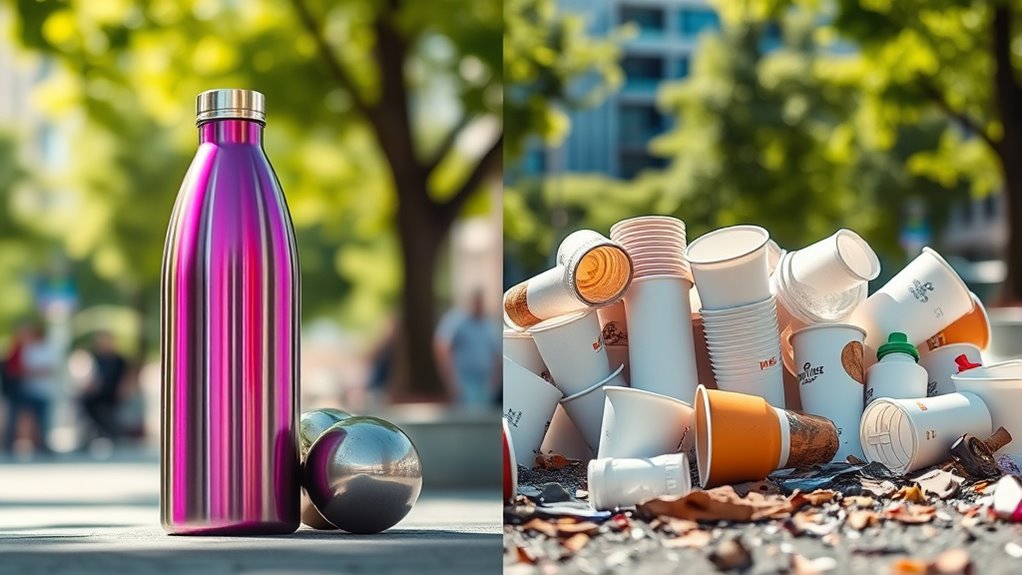
Have you considered how often you’ll actually use an item? If you plan to use a reusable product daily or multiple times a week, investing in durability makes sense. Reusables are designed to withstand frequent use, often lasting years with proper care. In contrast, disposables are meant for single use, so their durability isn’t a concern. Think about your habits: if you use something sparingly, disposables might be more practical. But if you’ll rely on it regularly, a durable reusable will save you money over time. Durability directly impacts how many uses you get from each item, influencing the break-even point. The more frequently you use an item, the more justified your investment in a sturdy, long-lasting reusable becomes. Additionally, bike tires made from plant-based materials can enhance their environmental benefits and longevity.
Cost per Use Analysis

While durability determines how many times you can reuse an item, understanding the cost per use helps you evaluate whether your investment makes financial sense. To do this, divide the total cost of the item by its estimated number of uses. For example, a reusable mug costing $10 and lasting 500 uses has a much lower cost per use than a disposable mug costing $1 each. Considering environmental impact can further influence your decision to choose reusable options over disposable ones. Additionally, incorporating energy efficiency ratings can help you select more sustainable and cost-effective options. Here’s a quick comparison:
| Item Type | Cost per Item | Uses Allowed/Estimated | Cost per Use |
|---|---|---|---|
| Reusable Mug | $10 | 500 | $0.02 |
| Disposable Cup | $1 | 1 | $1.00 |
| Reusable Bag | $15 | 1,000 | $0.015 |
This analysis helps you determine which option offers better value over time. Incorporating sustainable practices can further enhance the long-term savings and environmental benefits of choosing reusable items. Additionally, considering durability can help maximize the number of uses and optimize cost efficiency.
Waste Management and Disposal Expenses
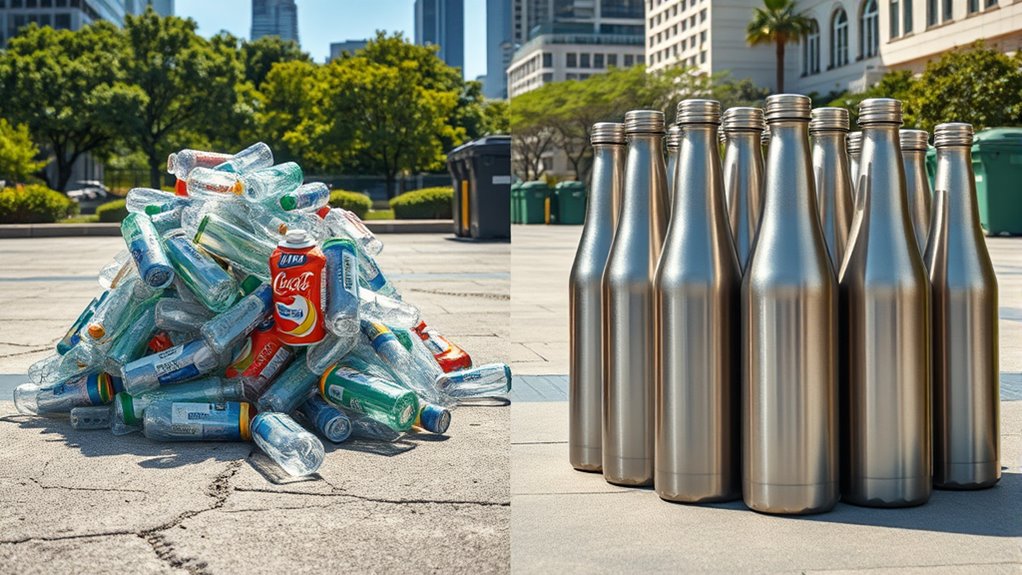
You’ll want to compare disposal costs for reusable and disposable items, as waste management expenses can vary widely. Reusables often reduce long-term disposal costs, but initial waste processing might be higher. Considering how each option impacts waste reduction can help you make a more cost-effective and environmentally friendly choice. Additionally, understanding the environmental benefits of reusable products can further inform your decision-making process. In some cases, the cost-benefit analysis of reusables demonstrates significant savings over time, especially when factoring in reduced waste disposal fees. Evaluating waste management practices can also reveal opportunities for increasing overall cost savings and sustainability. Incorporating proper waste sorting can further enhance recycling and reuse efforts, leading to even greater environmental and financial benefits.
Disposal Cost Comparison
When comparing disposal costs, reusable items generally incur lower waste management expenses over time, whereas disposables can lead to higher ongoing disposal fees. Reusables are used multiple times, so you’re spreading the disposal costs across many uses, reducing the per-use expense. In contrast, disposables generate continuous waste, requiring frequent collection, transportation, and processing. These ongoing costs add up, especially if disposal fees are volume-based or tiered. Additionally, some waste management facilities charge higher fees for contaminated or non-recyclable waste, which can further increase costs for disposables. Over time, the cumulative disposal expenses for disposables often surpass those of reusables, making the latter more economical from a waste management perspective. Managing waste efficiently helps control overall expenses and minimizes environmental impact, especially when considering sustainable waste practices that promote recycling and eco-friendly disposal methods. Implementing waste reduction strategies can further optimize disposal costs and support environmentally conscious choices, aligning with broader environmental sustainability goals. Incorporating a comprehensive waste management plan can also improve efficiency and reduce unnecessary disposal expenses. Additionally, understanding the true costs of waste can help in making more informed decisions about material usage and disposal methods.
Waste Reduction Impact
Choosing reusable items markedly reduces waste management and disposal expenses by decreasing the volume of waste sent to landfills and processing facilities. When you opt for reusable products, fewer single-use items end up in waste streams, which cuts the costs associated with collection, transportation, and processing. Landfills become less burdened, and waste treatment facilities operate more efficiently, lowering overall expenses. This reduction in waste volume also minimizes environmental impacts, such as leachate and greenhouse gas emissions. Over time, these savings accumulate, making reusable options more economical. Additionally, less waste means fewer trips for waste trucks, conserving fuel and reducing maintenance costs. Overall, your choice to use reusables not only benefits the environment but also substantially impacts waste management expenses.
Environmental Impact Considerations

While reusable items are often praised for their durability, their environmental impact depends heavily on factors like production, usage, and disposal. Manufacturing reusable products typically consumes more resources and energy upfront, which can offset their long-term benefits if you don’t use them enough. Additionally, the cleaning process for reusables—such as washing and sterilizing—uses water, electricity, and cleaning agents, contributing to their environmental footprint. Disposal methods also matter; if a reusable product isn’t properly recycled or ends up in a landfill, it adds to waste and pollution. Conversely, disposables generate waste quickly but often require less resource-intensive manufacturing. Overall, understanding these impacts helps you make more eco-conscious choices, considering not just waste reduction but the full lifecycle of each product.
Break-Even Point Calculation

To determine whether reusable or disposable items are more environmentally and economically sustainable, you need to calculate the break-even point. This point shows when the initial higher cost of reusables is offset by savings over time. To do this, compare the purchase price, cleaning or maintenance costs, and lifespan of each option. Use this simple table to visualize:
| Item Type | Initial Cost | Cost per Use | Total Uses to Break Even |
|---|---|---|---|
| Reusable | Higher | Lower | Calculated value |
| Disposable | Lower | Higher | N/A |
| Break-Even | – | – | When savings match cost |
Once you identify the total uses needed, you can decide which option makes more sense for your situation.
Long-Term Savings and Decision Factors
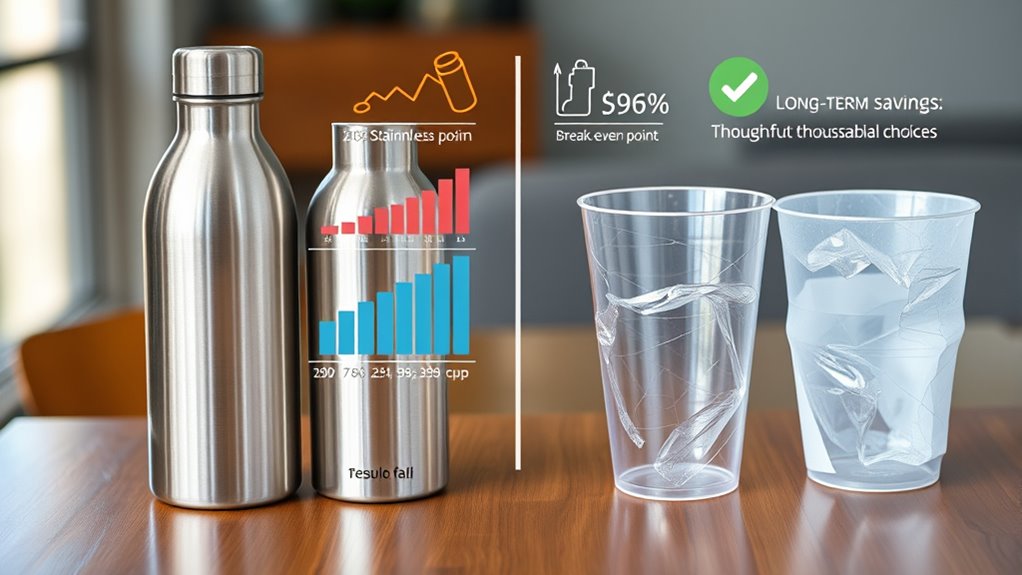
Long-term savings depend on more than just initial costs; they also involve factors like durability, maintenance, and usage frequency. If you choose reusable options, you might face higher upfront expenses but benefit from extended lifespan and lower per-use costs over time. Disposable products often seem cheaper initially but can add up quickly if you use them frequently, leading to higher overall expenses. Consider how often you’ll use the item and how well it holds up over time. Maintenance costs, repair needs, and replacement frequency all influence your total savings. Your decision should balance these factors with your budget and sustainability goals. By evaluating long-term implications, you can make smarter choices that save money and minimize waste in the long run.
Frequently Asked Questions
How Do Disposable and Reusable Options Compare in Different Industries?
When comparing disposable and reusable options across industries, you need to contemplate factors like cost, environmental impact, and durability. Reusables often cost more upfront but save money over time, while disposables are cheaper initially but may add up with frequent use. Your choice depends on industry-specific needs, such as hygiene standards or waste management, and balancing short-term expenses with long-term benefits.
What Are the Health and Safety Considerations for Reusable Products?
When considering reusable products, you need to prioritize health and safety by thoroughly cleaning and sanitizing them after each use. You should follow industry-specific guidelines for proper disinfection to prevent contamination. Regular inspections are essential to identify damage or wear that could compromise safety. Always verify you’re using the right cleaning agents and techniques. By maintaining strict hygiene practices, you protect yourself and others from potential health risks associated with reusables.
How Does Consumer Behavior Influence Break-Even Points?
Imagine choosing between convenience and sustainability. Your buying habits, like frequent use of disposables or choosing reusables, directly impact the break-even point. If you switch to reusables and use them often, you’ll reach cost savings faster. Conversely, infrequent use stretches out the time to break even. Your behavior, including proper maintenance and consistent use, influences when reusables become more economical than disposables.
Are There Government Incentives for Using Eco-Friendly Options?
You might wonder if government incentives encourage eco-friendly choices. Many governments offer benefits like tax credits, rebates, or grants to promote sustainable practices. These incentives can make eco-friendly options more affordable and appealing, helping you reduce your environmental impact. By taking advantage of such programs, you can save money while supporting green initiatives. Always check local policies to see what incentives are available in your area for choosing eco-friendly products and services.
How Do Supply Chain Disruptions Affect Reusable Item Availability?
Supply chain disruptions can markedly impact your access to reusable items. When shipments are delayed or interrupted, it becomes harder to maintain a steady stock of reusable products like containers or utensils. This can lead you to rely more on disposables temporarily. To mitigate this, you might need to plan ahead, seek local suppliers, or stock up during stable periods. Staying flexible and informed helps you keep eco-friendly options available despite disruptions.
Conclusion
Now that you’ve looked at both sides, it’s clear that choosing between reusable and disposable items depends on your habits and priorities. You might find that the initial costs are just the tip of the iceberg, and the true savings come over time. Remember, don’t put all your eggs in one basket—consider the break-even point and environmental impact before making your decision. Ultimately, it’s about finding the best fit for your lifestyle and values.





